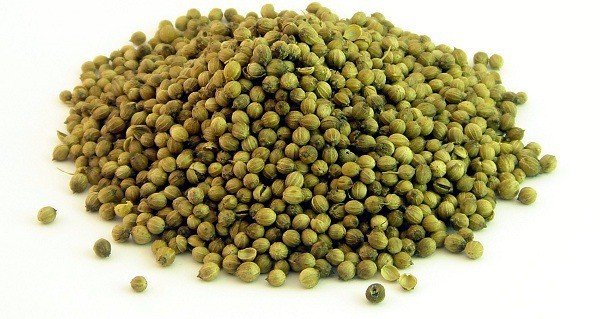Coriander

Coriander is a herbaceous, light-loving plant belonging to the umbelliferae family, whose leaves resemble those of parsley.
The plant blooms in early summer with white or pink umbrella-shaped flowers, and its ovoid-globose fruits ripen in July.
The seeds of the plant are called coriander. This plant from the umbelliferous family was used as a spice and medicine as far back as Ancient Greece and Rome, from where it was imported to other continents.
Coriander is mentioned in an ancient Egyptian medical treatise. Coriander is now grown in many countries and is used as a spice, medicine and source of essential oil.
Beneficial properties
Coriander has an antispasmodic, antiseptic, carminative, choleretic and mild laxative effect, and also actively stimulates the function of the digestive glands.
This spice improves digestion and enhances the secretion of gastric juices, which helps to get rid of the heaviness in the stomach after a large meal.
A distinctive property of coriander is its ability to deal with the main causes of allergies affecting digestion.
This excellent remedy has long been used together with fennel for excessive flatulence. One of the most famous phytotherapists of the past century in Bulgaria, P. Dimkov, recommended the consumption of coriander after intestinal infections (for example, typhoid and stomach flu) to restore normal digestive processes.
The beneficial properties of this spice are determined by the ingredients included in its composition – vitamins A, B1, PP, B2, B4, B5, B6, B9, K, tocopherol, ascorbic acid and macronutrients – potassium /521 mg per 100 grams of leaves /, phosphorus, calcium, magnesium and sodium; trace elements – iron and zinc /1.77 mg and 0.5 mg respectively per 100 grams of green leaves/, as well as manganese, copper and selenium.
In terms of content of carotene, rutin and a number of other vitamins, coriander surpasses many other plants that are used as spices, and it contains more vitamin C than lemon /27 mg per 100 grams of green leaves/.
The calorie content of coriander is 23 kilocalories per 100 grams of green leaves.
For therapeutic purposes and to improve digestion, decoctions and tinctures of coriander seeds are primarily used.
For this purpose, a teaspoon of crushed seeds is poured with a glass of cold water and left in a closed container for an hour.
Usually, the infusion is taken up to 4 times a day, 0.25 cup half an hour before meals. Such a tincture is used as an adjuvant in the treatment of colds, chronic coughs and pleurisy.
Coriander is effectively used in the preparation of healing mixtures – as a choleretic along with immortelle and mint leaves, in gallstone disease – with the fruits of anise, St. John’s wort and dandelion root.
In folk medicine, coriander seeds are included in the composition to enhance sexual functions, and together with this spice and parsley, mixtures are prepared for the treatment of impotence.
The fresh juice of coriander leaves is considered an excellent hemostatic agent. According to historical sources, Hippocrates spoke about the effectiveness of the application of this spice, as an herb for hysteria.
Also, coriander fruits are recommended for relieving tension in stressful situations and in the treatment of depression.
Contraindications for the use of coriander
This plant is absolutely contraindicated in pregnancy. Also, during this period, its essential oil should not be used.



